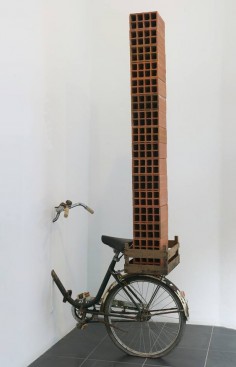Carlos No
Pillar
source: highlike
Work: This work, entitled “Pillar”, belongs to a series – “Villa Bidão” (Braggart City) – which comprises a set of sculptures which follows the line of the artist’s more recent works, formally and conceptually. Once again Carlos No seeks to draw attention to certain aspects or situations of the present-day world that arouse feelings of revolt or nonconformity in the author. Carlos No always starts out from provocative themes, and in this case it is the evidence of a misery which has become an integral part of a given architectural and social dimension: shanty towns. In this set of sculptures, the artist seeks to evoke the idea of a shanty town as a place unsuitable for habitation – a cluster of improvised and fragile dwellings, with no infrastructures or basic sanitation – and, with this in view, he resorts to shoddy or used materials which he then recycles and/or transforms, according to a logic of construction identical to that of his referents, yet without ceasing to create new lines of interpretation for the proposed theme. Through his critical and incisive approach he denounces some of the negative traits of contemporary societies, addressing issues such as those of poverty and exclusion, consolidating a path related with the problem of economic and social asymmetries and the impact of these on the lives of billions of people who, in the great majority, are deprived of minimum standards of living such as the right to decent housing or other things essential to life, like access to drinking water.
Statement: Born in Lisbon, in 1967. Lives and works in Ericeira, Portugal. Studied painting at AR.CO – Centro de Arte e Comunicação Visual in Lisbon, 1987/1992, and sculpture in 1987. Since 1991 he has taken part in various group shows both in Portugal and abroad, and his first solo show was held in 1994. In 1993 he was awarded the 1st Prize in painting at the Portimão Art Fair (Portugal), and in 1995 was selected for the Portuguese representation at the Biennale of Young Artists of Europe and the Mediterranean, in Rijeka, Croatia. Nowadays he works with Arthobler Gallery in Zurich, Switzerland, the Elizabeth Couturier Gallery in Lyon, France, and the Maaret Finnberg Gallery in Turku, Finland. Carlos No is represented in institutional and private collections in Portugal and in private collections in Belgium, Brazil, the Czech Republic, France, Germany, Hungary, Mexico, the Netherlands and Spain.
Photographer: Josef Kaempf
.
.
.
.
.
.
.
source: darsmagazineit
Carlos No è un giovane artista portoghese, sensibile e complesso, che comunica essenzialmente attraverso immagini, testi e oggetti semplici. I suoi sono messaggi forti. Attraverso un linguaggio rapido, facilmente interpretabile e volutamente ironico, esprime le sue preoccupazioni e la sua critica in relazione ai temi sociali più attuali. (…) Il tuo lavoro rivela, in forma chiara, una preoccupazione, un’inquietudine sociale. È qualcosa che é rilevante in queste tue ultime opere, ma che si riconosce anche nei tuoi lavori anteriori. Credi che l’arte abbia l’obbligo di assumere una posizione sociale? No. Non credo proprio che l’arte “abbia l’obbligo di assumere una posizione sociale”. Anzi, detto così mi suona addirittura imperativo. Quello che penso é che in campo artistico possano e debbano esistere più forme espressive, di ricerca, di interrogazione, e come tale, anche un arte più connessa alle preoccupazioni e questioni di ordine sociale. È il mio caso, una forma tra varie possibili.
.
.
.
.
.
.
.
source: designboom
portuguese artist carlos no‘s series of sculptural works ‘villa bidão’ (braggart city) draw attention to societal issues such as poverty and deprivation, particularly the lives of billions of people without access to housing or drinking water. the improvised dwellings made from makeshift and recycled materials lack a stable framework and basic sanitation, recall the idea of a shanty town as a place unsuitable for habitation. through their metaphorical undertones — huge barrels evocative of a heavy burden and worn materials personifying neglect, the objects present subjects of scarcity and exclusion through visual artworks. one exhibited sculpture titled ‘weekend’ is a rusty motor tricycle with a wooden house on top, reminiscent of a caravan. the piece is intended as an ironic message, as its name ‘weekend’ references a society which has access to rest and leisure, while the conditions of the construction are run-down, summoning the impression of poor living conditions.
.
.
.
.
.
.
.
source: mydesignstories
Portuguese artist carlos nogueira‘s series of sculptural works ‘villa bidão’ (braggart city) draw attention to societal issues such as poverty and deprivation, particularly the lives of billions of people without access to housing or drinking water. The improvised dwellings made from makeshift and recycled materials lack a stable framework and basic sanitation, recall the idea of a shanty town as a place unsuitable for habitation. through their metaphorical undertones — huge barrels evocative of a heavy burden and worn materials personifying neglect, the objects present subjects of scarcity and exclusion through visual artworks. One exhibited sculpture titled ‘weekend’ is a rusty motor tricycle with a wooden house on top, reminiscent of a caravan. the piece is intended as an ironic message, as its name ‘weekend’ references a society which has access to rest and leisure, while the conditions of the construction are run-down, summoning the impression of poor living conditions.


